
Dr. Antonio Castilla
Assistant Professor
Dept. of Plant Biology, Ecology, and Evolution
423 Physical Sciences, Stillwater, OK 74078-3013, USA
405-744-4742
Teaching
BIOL 3034 General Ecology, every semester
An overview of the study of organisms interacting with each other and their environment at individual, population, community, and ecosystem levels of organization. Includes human interaction with ecological systems.
Research
My research program examines the genetic and ecological processes enabling plant populations to cope with global change. I am particularly insterested in the evolutionary forces that shape genetic and phenotypic variation in plants, such as gene flow across hierarchical spatial scales in plant distributions and local adaptation to biotic/abiotic environments.
Recent Publications
Castilla AR, Brown A, Hoban S, Noakes E, Robinson JD, Romero-Severson J, Smith AB, Strand AE, Tipton JR, Dawson A. In review. Integrative demographic modeling reduces uncertainty in estimated rates of species’ historical range shifts. Journal of Biogeography.
Méndez‐Vigo B, Castilla AR, Gómez R, Marcer A, Alonso‐Blanco C, Picó FX. In press. Spatio‐temporal dynamics of genetic variation at the quantitative and molecular levels within a natural Arabidopsis thaliana population. Journal of Ecology.
Garrote PJ, Castilla AR, Fedriani JM. 2022. The Eurasian badger-generated seed rain of a keystone pioneer palm drives the natural (re)colonization of vacant human-altered areas. Perspectives in Plant Ecology, Evolution and Systematics, 125685.
Garrote PJ, Castilla AR, Fedriani JM. 2022. Coping with changing plant-plant interactions in restoration ecology: Effects of species, site, and individual variation. Applied Vegetation Science 25, e12644.
Picó FX, Abdelaziz M, Castilla AR. 2021. Introduction to the Special Issue: The ecology and genetics of population differentiation in plants. AoB PLANTS 13, plab057.
Garrote PJ, Castilla AR, Fedriani JM. 2021. Assessing the relative importance of nurse species on Mediterranean human-altered areas. Restoration Ecology e13402.
Selwyn M, Garrote PJ, Castilla AR, Fedriani JM. 2020. Interspecific interactions among functionally diverse frugivores and their outcomes for plant reproduction: a new approach based on camera-trap data and tailored null models. PLoS One 15: e0240614
Castilla AR, Mendez-Vigo B, Marcer A, Martinez-Minaya J, Conesa D, Picó FX, Alonso-Blanco C. 2020. Ecological, genetic and evolutionary drivers of regional genetic differentiation in Arabidopsis thaliana. BMC Evolutionary Biology 20: 1-13.
Ballare KM, Pope NS, Castilla AR, Cusser S, Metz RP, Jha S. 2019. Utilizing field collected insects for next generation sequencing: effects of sampling, storage, and DNA extraction methods. Ecology and Evolution 9: 13690-13705.
Castilla AR, Garrote PJ, Żywiec M, Calvo G, Suárez-Esteban A, Delibes M, Godoy JA, Picó FX, Fedriani JM. 2019a. Genetic rescue by distant trees mitigates qualitative pollen limitation imposed by fine-scale spatial genetic structure. Molecular Ecology 28: 4363-4374.
Garrote PJ, Castilla AR, Fedriani JM. 2019. The endemic Mediterranean dwarf palm boosts the recolonization of old-fields: implications for restoration. Journal of Environmental Management 250: 109478.
Garrote PJ, Calvo G, Żywiec M, Delibes M, Suárez-Esteban A, Castilla AR, Fedriani JM. 2019. Extrinsic factors rather than seed traits mediate strong spatial variation in seed predation. Perspectives in Plant Ecology, Evolution and Systematics 38: 39-47.
Castilla AR, Godoy JA, Delibes M, Rodriguez‐Prieto A, Fedriani JM. 2019b. Microgeographical variation in recruitment under adult trees: arrival of new genotypes or perpetuation of the existing ones? Plant Biology 21: 695-705.
Fedriani JM, Garrote PJ, Calvo G, Delibes M, Castilla AR, Żywiec M. 2019. Combined effect of seed provenance, plant facilitation, and restoration site on revegetation success: lessons from a threatened Mediterranean tree population. Journal of Applied Ecology 56: 996-1006.
Majetic CJ, Castilla AR, Levin DA. 2019. Losing a Scent of One’s Self: Is There a Reduction in Floral Scent Emission in Self-Pollinating Phlox cuspidata versus Outcrossing Phlox drummondii? International Journal of Plant Sciences 180: 86-92.
O'Connell MC, Castilla AR, Lee LX, Jha S. 2018. Bee movement across heterogeneous tropical forests: multi‐paternal analyses reveal the importance of neighborhood composition for pollen dispersal. Biotropica 50: 908-918.
Buide ML, del Valle JC, Castilla AR, Narbona E. 2018. Sex expression variation in response to shade in gynodioecious-gynomonoecious species: Silene littorea decreases flower production and increases female flower proportion. Environmental and Experimental Botany 146: 54-61.
Castilla AR, Pope NS, O'Connell MC, Rodriguez MF, Treviño L, Santos A, Jha S. 2017. Adding landscape genetics and individual traits to the ecosystem function paradigm reveals the importance of species functional breadth. Proceedings of the National Academy of Sciences 114: 12761-12766.
Castilla AR, Pope NS, Jaffé R, Jha S. 2016a. Elevation, not deforestation, promotes genetic differentiation in a pioneer tropical tree. PLoS One 11: e0156694.
Castilla AR, Alonso C, Herrera CM. 2016b. To be or not to be better pollinated: differences between sex morphs in marginal gynodioecious populations. Special Issue: “The Ecology and Evolution of Pollen Performance” American Journal of Botany 103: 388-395.
Castilla AR, Pope NS, Jha S. 2016c. Positive density-dependent reproduction regulated by local kinship and size in an understory tropical tree. Annals of Botany 117: 319-329.
Jaffé R, Castilla AR, Pope NS, Imperatriz-Fonseca VL, Metzger JP, Arias MC, Jha S. 2015. Landscape genetics of a tropical rescue pollinator. Conservation Genetics 17: 267-278.
Castilla AR, Alonso C, Herrera CM. 2015. Sex-specific phenotypic selection and geographic variation in gender divergence in a gynodioecious shrub. Plant Biology 17: 186-193.
Castilla AR, Alonso C, Herrera CM. 2013. Herbivory at marginal populations: consequences for maternal fitness and vegetative differentiation. Acta Oecologica 49: 32-38.
Castilla AR, Wiegand T, Alonso C, Herrera CM. 2012a. Disturbance-dependent spatial distribution of sexes in a gynodioecious understory shrub. Basic and Applied Ecology 13: 405-413.
Castilla AR, Alonso C, Herrera CM. 2012b. Genetic structure of the shrub Daphne laureola across the Baetic Ranges, a Mediterranean glacial refugium and biodiversity hotspot. Plant Biology 14: 515-524.
Castilla AR, Alonso C, Herrera CM. 2011. Exploring local borders of distribution in the shrub Daphne laureola: individual and population traits. Acta Oecologica 37: 269-276.
